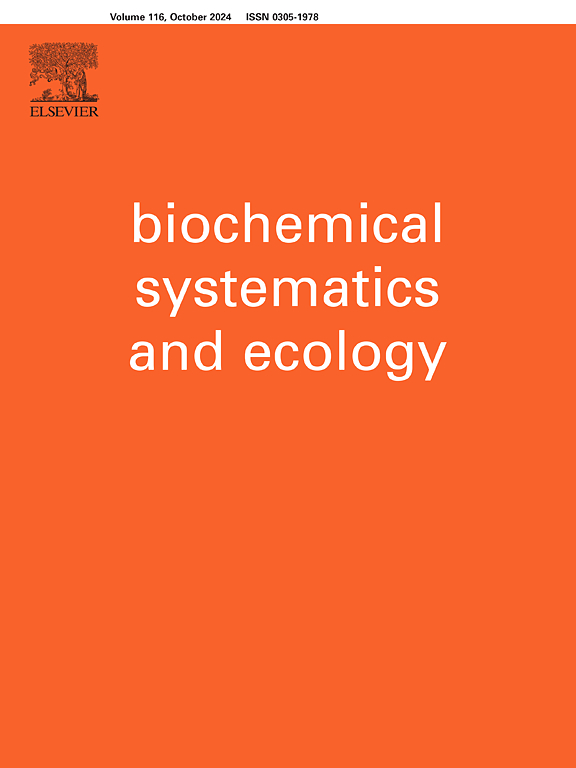Influence of seasonal climatic variation on volatile organic compounds of Drimys brasiliensis leaves and its impact on the antitumor activity
IF 2
4区 生物学
Q4 BIOCHEMISTRY & MOLECULAR BIOLOGY
引用次数: 0
Abstract
Understanding the biosynthesis and accumulation of volatile organic compounds in response to seasonal abiotic stress is essential for optimizing essential oil extraction and promoting the conservation of native species through their sustainable use. Accordingly, the present study investigates the yield, chemical composition, and antitumor activity of essential oil from Drimys brasiliensis leaves, analyzing how these characteristics vary in response to climatic conditions throughout the year. The essential oil yield ranging from 0.07 g (January 2019) to 0.30 g (August 2018) per 100 g of fresh leaves. Seasonal analysis showed statistically significant differences with lower yields during the summer, coinciding with the species' flowering phase. The chemical composition of the essential oil included 33 components, with 27 identified. The primary compounds were limonene (14.67–26.21 %), bicyclogermacrene (7.35–21.35 %), sabinene (2.70–9.89 %), β-pinene (6.51–9.21 %), and α-pinene (5.28–7.20 %). Seasonal variation in volatile compound accumulation was observed, with limonene and bicyclogermacrene showing higher levels during the flowering period. Climatic factors, particularly temperature, precipitation, and wind from the current and preceding two months, significantly influenced the relative amounts of specific components, as evidenced by Spearman correlation analysis. The essential oil from leaves sampled in specific months (August 2019, March 2019, January 2019, and December 2018) exhibited antitumor activity against the MDA-MB-231 breast cancer cell line. This study offers new insights into the accumulation of essential oil components, providing guidance for species management focused on sustainable use and conservation.
季节气候变化对巴西木叶片挥发性有机物的影响及其对抗肿瘤活性的影响
了解挥发性有机化合物在季节性非生物胁迫下的生物合成和积累对优化精油提取和通过可持续利用促进本地物种的保护至关重要。因此,本研究研究了巴西油树叶片精油的产量、化学成分和抗肿瘤活性,并分析了这些特性在全年气候条件下的变化。每100克鲜叶的精油产量从0.07克(2019年1月)到0.30克(2018年8月)不等。季节分析表明,在夏季,与该物种的花期一致,产量较低,差异具有统计学意义。精油的化学成分包括33种成分,其中27种已确定。主要化合物为柠檬烯(14.67 ~ 26.21%)、双环绿烯(7.35 ~ 21.35%)、沙宾烯(2.70 ~ 9.89%)、β-蒎烯(6.51 ~ 9.21%)和α-蒎烯(5.28 ~ 7.20%)。挥发性化合物积累有季节变化,在开花期柠檬烯和双环革烯含量较高。斯皮尔曼相关分析证明,气候因素,特别是当前和前两个月的温度、降水和风,显著影响了特定成分的相对数量。在特定月份(2019年8月、2019年3月、2019年1月和2018年12月)取样的叶子精油显示出对MDA-MB-231乳腺癌细胞系的抗肿瘤活性。本研究为植物精油成分的积累提供了新的认识,为植物的可持续利用和保护提供了指导。
本文章由计算机程序翻译,如有差异,请以英文原文为准。
求助全文
约1分钟内获得全文
求助全文
来源期刊

Biochemical Systematics and Ecology
生物-进化生物学
CiteScore
3.00
自引率
12.50%
发文量
147
审稿时长
43 days
期刊介绍:
Biochemical Systematics and Ecology is devoted to the publication of original papers and reviews, both submitted and invited, in two subject areas: I) the application of biochemistry to problems relating to systematic biology of organisms (biochemical systematics); II) the role of biochemistry in interactions between organisms or between an organism and its environment (biochemical ecology).
In the Biochemical Systematics subject area, comparative studies of the distribution of (secondary) metabolites within a wider taxon (e.g. genus or family) are welcome. Comparative studies, encompassing multiple accessions of each of the taxa within their distribution are particularly encouraged. Welcome are also studies combining classical chemosystematic studies (such as comparative HPLC-MS or GC-MS investigations) with (macro-) molecular phylogenetic studies. Studies that involve the comparative use of compounds to help differentiate among species such as adulterants or substitutes that illustrate the applied use of chemosystematics are welcome. In contrast, studies solely employing macromolecular phylogenetic techniques (gene sequences, RAPD studies etc.) will be considered out of scope. Discouraged are manuscripts that report known or new compounds from a single source taxon without addressing a systematic hypothesis. Also considered out of scope are studies using outdated and hard to reproduce macromolecular techniques such as RAPDs in combination with standard chemosystematic techniques such as GC-FID and GC-MS.
 求助内容:
求助内容: 应助结果提醒方式:
应助结果提醒方式:


